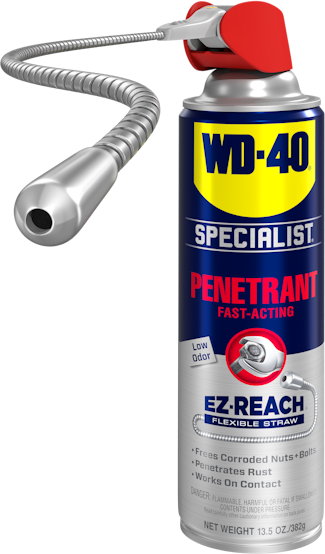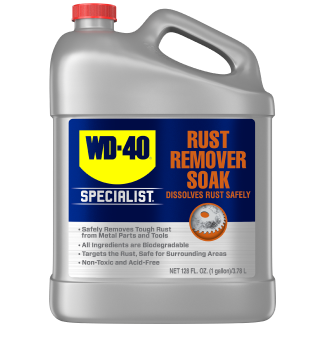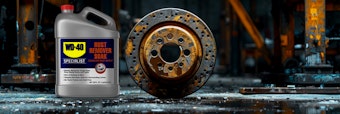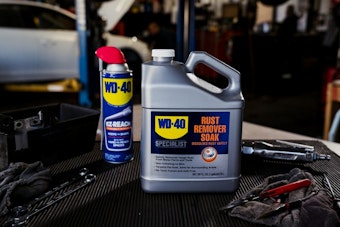DIY Rust Protection: How to Use Rust Prevention Spray
DIY Rust Protection: How to Use Rust Prevention Spray
<< BackHave you ever noticed that everything seems to be rusted when watching a post-apocalyptic movie?
It’s probably the lack of access to rust prevention sprays – a bleak dystopian future to be sure. We mean, if rust prevention sprays were readily available, we would see shiny relentless machines instead of their rusty counterparts. Rust, much like these nightmarish machines, can wreak havoc on equipment, causing increased wear and tear, decreased efficiency, premature failure and various safety hazards.
Thankfully, today we still have access to all kinds of rust prevention products. To mitigate the risks of rust and ensure that your equipment stays protected, an effective rust prevention maintenance schedule is imperative. Rust prevention sprays are a key part of this.
To better understand how to protect your equipment and implement an effective rust prevention maintenance schedule, we’ll first deep dive into the inner workings of rust.
Understanding Rust
Rust is a form of corrosion that affects metals like steel and iron. To be more specific, corrosion is the process during which metals react with moisture and oxygen over a period of time. This process results in rust, the reddish-brown flaky coating on a metal’s surface.
Iron oxide, or rust as we will refer to it going forward, is caused by various environmental factors, including:
Moisture:
Moisture, i.e. water is a key component in the rusting process. Metals exposed to rain, humidity, or even condensation are more prone to rusting.
Oxygen:
The presence of oxygen is crucial for rust to form, as rust is in its essence a metal oxide (think iron and oxygen together). Metals exposed to air, especially in humid environments, tend to rust quicker.
Salts:
Salts like sodium chloride (table salt), accelerate the rusting process. This is why metals in coastal environments, which contain salt from the ocean in the air, rust faster.
pH levels:
Metals exposed to environments that are acidic in nature, tend to rust faster than those in neutral environments. An example is metal in a refinery, due to the acidic nature of the air, accredited to industrial processes, the metal rusts much faster than say metal in your home (we hope!).
Mechanical damage:
Scratches, dents and other forms of mechanical damage can expose fresh metals to the environment, making them more susceptible to rusting.
Now that we understand rust and the environmental factors that contribute to it, the question becomes, how do you choose the correct rust prevention spray?
Choosing the Right Rust Prevention Spray
When considering a rust prevention spray, there are a few factors to consider, including the type of metal, ease of use, its efficiency and most importantly its ability to prevent rust.
Type of Metal
Ensure that the spray you intend to use is suitable to the specific metal you are treating. The WD-40 Specialist Penetrant is suited for most metals including steel, iron, aluminum, and chrome.
Ease of Use
When it comes to choosing a rust prevention spray, ease of use is one of the most important factors to consider.
When it comes to convenience, we have you covered with the WD-40 Specialist Penetrant. It comes in a Smart Straw Sprays 2 Ways applicator allowing application with a pinpoint stream, or when the straw is folded down, a wide-angle spray. It also comes in an EZ-reach flexible straw variant boasting an 8” flexible straw that can bend and keep its shape.
Efficiency and Future Rust Protection
The ability of a rust prevention spray to protect metals from future rusting is crucial. WD-40 Specialist Penetrant penetrates rust 2x faster than its competitors and also prevents rust 10x longer than its peers. This makes it one of the most powerful rust prevention sprays available on the market.
Step-by-Step Guide to Using Rust Prevention Spray
Regardless of which rust prevention spray you intend to use, below we provide a step-by-step guide on how to use any general rust prevention spray.
To get started, grab a can of your preferred rust prevention spray, we suggest using WD-40 Specialist Penetrant. Also, have a cleaning agent handy and ensure to wear the suggested personal protective equipment (PPE). Depending on the surface and if there is rust present, have either some steel wool or a wire brush at the ready. As always, be sure to follow the safety guidelines provided by the manufacturer.
- Clean the Surface: Gather the required materials mentioned above and ensure to put on your PPE. From here, the first step is to clean the metal surface to ensure there are no contaminants present. We suggest using WD-40 Specialist Cleaner & Degreaser for this. Thoroughly clean the surface and wipe off any contaminants.
- Prepare the Area: If there is rust present on the surface of the part or object you aim to protect, it is necessary to first remove the rust. Use either your steel wool or wire brush to remove any surface rust. A much less labor-intensive way is to place the rusted object in WD-40 Specialist Rust Remover Soak.
- Application: After thoroughly cleaning the surface and removing any rust, grab your rust prevention spray and apply it evenly to the metal surface.
- Waiting Period: Let it sit for a few minutes to penetrate any crevices that may be present and to displace any moisture, a key part of rust prevention.
- Wipe Off Excess: After waiting, lightly wipe off any excess spray from the surface and you are ready to go!
Tips for Effective Rust Prevention
To get the most from using your rust prevention spray, be certain to follow our helpful tips below:
Safety Precautions
Follow the safety guidelines provided by the manufacturer and wear the correct PPE. This will allow you to carry out any activity safely and effectively.
Best Practices for Achieving Optimal Results
- Work in a Well-Ventilated Area: Proper ventilation helps dissipate fumes, making it safer and more comfortable to work.
- Clean the Surface Thoroughly: We touched on this previously, but be sure to remove any dirt, debris or loose rust with a cleaner and degreaser and steel wool or wire brush.
- Shake the Spray Well Before Use: Ensure the rust prevention spray is well-mixed by shaking the can thoroughly before use. This ensures a homogenous mixture and a more powerful performance.
- Apply Evenly: Spray an even coat on the area, ensuring it covers all spots.
- Follow the Manufacturer Instructions: Ensure to follow the instructions provided by the manufacturer, including application and waiting times.
By following these best practices you will be able to get the most from your rust prevention spray. There are, of course, additional steps one can take to ensure mitigation of future rusting, including:
Regular Inspections
Be sure to inspect your equipment and machinery regularly for any signs of rust, including small rust spots or discoloration. Early detection can prevent small rust areas from becoming large challenges.
Proper Storage
Ensure you don't store your metal parts in high-moisture environments. Keep your parts and equipment in dry areas.
The Master Tech Seal of Approval
From the discussion above it becomes clear that rust prevention sprays are a necessary component in the toolbelt of any seasoned technician. Randy, a seasoned professional and owner of Mission Hills Automotives, shares his experience in using WD-40 Specialist products to tackle rust.
As a 35-year certified ASE master technician, Randy utilizes the WD-40 Specialist products range in various applications to bust rust. From surface rust that he easily tackles by using WD-40 Specialist Penetrant, to heavy-duty rust that he removes with the use of WD-40 Specialist Rust Remover Soak. Randy ascribes his vehicle components’ rust-free sparkle to WD-40.
All we’re saying, after reading about the effectiveness of rust prevention sprays and the pivotal role that the WD-40 Specialist Product range plays in it, is that those relentless futuristic machines really have no reason not to shine.
FEATURED PRODUCTS
WANT TO GET MORE TIPS AND TRICKS?
SUBSCRIBE TO THE NEWSLETTER



